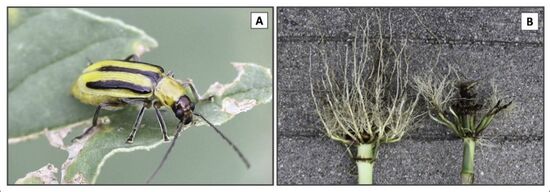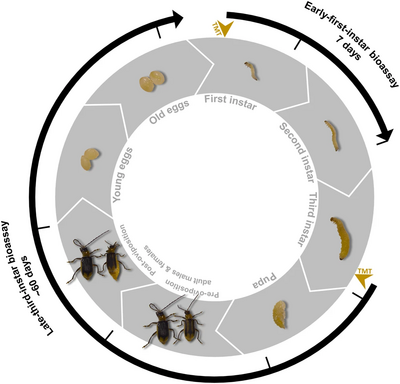Brevibacillus laterosporus, a bacterial biological control agent of Western Corn Rootworm
Background

By Katya Naphtali
Underneath the umbrella of “pesticides”, there are biologically synthesized alternatives to chemicals called microbial pesticides. This alternative uses different microorganisms to target specific pests that threaten production. The actual material used as a pesticide is naturally formed, biodegradable, highly specialized to specific pests rather than having widespread impact with the added benefit that they can be used in small quantities with large effects [1].
This technique of pest control is commonly used to address damage incurred by the Western Corn Rootworm (CRW), which is specialized to parasitize corn monocropping productions [2]. Damage incurred from CRW infestation of corn crops costs the United States a total of $2 billion annually (Wechsher et al. 2018)
A common management process to address CRW is the incorporation of microbial pesticides into corn GMO strains. A number of crops including cotton, soybeans, and corn are genetically engineered to contain genes sources from a soil bacteria, Bacillus thuringiensis, commonly referred to as Bt. This species is most commonly used for microbial pest control targetted at Coleopteran species (Fernandez-Cornejo et al.). The toxins produced by Bacillus bacteria attack cells in the larva’s midgut by causing the cells in their stomach lining to lyse (Paddock et al.) When genes for toxic protein production are incorporated into crops, the pests that parasitize these crops die from consuming these naturally synthesized toxic proteins (Fernandez-Cornejo et al.). These toxins can be incorporated into GMO crops, allowing for the corn plants themselves to produce these toxins and in effect protect themselves from CRW. Currently there are four strains of Bt corn that widely incorporated into corn productions (Paddock et al.)
Unfortunately, in some regions where these GMOs are overused, CRW has adapted resistance to this toxin [2] (Levine et al. 2002). Currently there are populations of of CRW that have evolved to be resistant to every Bt toxin we are aware of (Paddock et al.) This drives researchers to search for similarly effective bacteria to replace their current technology.
Diabrotica virgifera virgifera, Western Corn Rootworm

Diabrotica virgifera virgifera, otherwise known as Western Corn Rootworm, is a species of Coleoptera (which are beetles) that specialize only in eating varieties of corn, Zea mays. These beetles are ¼” long and yellow with black stripes along the sides of their elytra. They only have a single generation a year, because their life cycle is dependent on corn developmental stages (Strnad et al.). Adult beetles lay their egg clusters below the soil surface for generation the following year, before dying themselves in the first winter frost [2]. These eggs hatch during late May and early June into polypod larva that are long small and white but sport a scleritized brown head plate with strong mandibles. They spend most of their larval stage feeding on the root zone of soil. They tunnel through dirt until finding corn roots to feed on (Strnad et al.). This tunneling can kill an entire root or break the tips of them, this prevents the plant from recieving enough nutrients causing it to either fall over, or greatly damage growth. The plant can be weakened in terms of stunting growth, reducing the yield amount, or even reducing the size of each ear of corn [2].
These larva undergo three instars of molting over a 4-6 week period (Strnad et al.) & [3]. Before they pupate within the soil to undergo a compleme metamorphosis of their bodies into their adult forms. 5-10 days after pupation, CRW emerge as adults coinciding with when the corn plants flower (Strnad et al.) & [3]. CRW beetles still consume during their adult stages, mainly corn pollen and corn silk, sometimes their leaves as well. Corn silk and pollen are both are needed for corn to pollinate eachother, so adults reduce their ability to reproduce [2]. Despite these negative impact, it is still less than the damage caused during their larval stage feeding on roots [4].
In laying their eggs for the next generation, adult CRW are relatively stagnant species and do not tend to move fields for laying their eggs. As a result a common pest management technique for CRW is crop rotation with soy beans (Paddock et al.). Each year switching corn out for soybean plants prevents CRW from parasitizing their roots, causing CRW larva populations to drop due to the lack of their niche corn food source. Unfortunately, in some cases CRW have adapted to crop rotation schedules and have begun laying their eggs in soybean fields in anticipation of crop rotation to corn the following Spring when their offspring hatch [2]. This species adapts quickly due to its dependence on corn as its sole food source [5]. As a result, other forms of pesticides are needed to be used alongside crop rotation [2].
Most commonly, crop rotation is paired with the use of Bt corn crops, that have been genetically modified to produce these pest specific toxins themselves. These genetic modifications allow farmers to use less chemical pesticides while still reducing the damage incurred by pests, and increasing their overall crop yield (Fernandes-Cornejo et al.). Unfortunately Bt is widely used which has resulted in the emergence of multiple resistant strains of CRW both in Northwest Iowa and Southeast Minnesota. While these resistant populations may not be able to move far without accidental human transportation, they fortell the immunity that may be seen in other regions that over-use specific resistant strains. As a result, new bacterial strains are being investigated to create new resistant corn GMO archetypes. Similar to crop rotation, a rotation of toxins may introduce more variety in pest control techniques that they will be less able to adapt to [2].
Brevibacillus laterosporus
A number of Bacillus species have been investigated for pesticidal properties due to their formation of specialized biotoxins. Since the 1960s the most commonly used biotoxin has been those sourced from various strains of Bt. These bacteria are produced industrially in fermentation tanks and have widespread use for various different orders and species of insects (Weinzier et al.) As pest species become more resistant to Bt toxins, researchers have taken interest in a different but similar species of Bacillus, Brevibacillus laterosporus. In recent years BL has become a bacterial species of more interest due to the speed in which it produces biotoxins, even if less powerful of a toxin than Bt produced [6][7].
Brevibacillus laterosporus (Bl) is a gram-positive, rod-shaped bacteria about 3-5um in length and 0.7-1.0um in width. This bacteria is facultatively anaerobic (Cai et al.) meaning it can survive in environments with or without oxygen. It also can either be found as individual bacteria or in short chains (Prassanna et al.). Due to its metabolic flexibility, Bl can be sourced from soil, plants or even directly from insects themselves [6]. This bacteria reproduces by producing endospores. On one end of each spore, this species of bacteria can be identified by its production of canoe-shaped paraposal bodies (a crystallized shell) [6]. Bl produces a number of products including enzymes and prebiotic materials that function as an insecticides (Orlova et al.) Some of these insecticidal products are sourced from the crystallized structures of these parasposal bodies that contain endotoxins [6]. To extract these endotoxins, during cell lysis paraposal bodies detach from thel cell wall and can be removed as a precipitate. This material can then be utilized as a larvacide. Different strains of BL produce different shapes and structures of proposal bodies but their functional differences are unclear (Ruiu et al.) Additionally, some strains of Bl do not even form proposal bodies, but still are larvicidal (Oliveira et al.). While there are still many unknowns, Bl produces paraposal bodies and endotoxins at a higher rate than other species Bacillus making it optimal for industrial agricultural use (Ghazanchyan et al.).
Pathology & Experimental Use
Include some current research, with at least one figure showing data.
Real World Impacts
Conclusion
Bl poses a promising possibility for future GMO strains of Rootworm resistant corn. While this strain is not as powerful as BT, it holds the potential to be as lethal to pests, and due to its low usage in agriculture thus far, few pests will be resistant to its toxins.
References
- ↑ US EPA. 2022, “What are Biopesticides?” United States Environmental Protection Agency.
- ↑ 2.0 2.1 2.2 2.3 2.4 2.5 2.6 2.7 Cornell. “Northern and Western Corn Rootworms” Cornell University College of Agriculture and Life Sciences.
- ↑ 3.0 3.1 Corn Rootworm IPM Extension. 2023. “Corn Rootworm Life Cycles” Iowa State University of Science and Technology.
- ↑ Godfrey, L. D., L. J. Meinke, R. J. Wright, Affects of Larval Injury by Western Com Rootworm (Coleoptera: Chrysomelidae) on Gas Exchange Parameters of Field Corn, Journal of Economic Entomology, Volume 86, Issue 5, 1 October 1993, Pages 1546–1556.
- ↑ Rausher, Mark D. “Co-Evolution and Plant Resistance to Natural Enemies.” Nature 411, no. 6839 (June 2001): 857–64.
- ↑ 6.0 6.1 6.2 6.3 Ghazanchyan, N. L., M. H. Kinosyan, P. E. Tadevosyan, N. S. Khachaturyan, and E. G. Afrikian. “Brevibacillus Laterosporus as Perspective Source of New Bioinsecticides.” Annals of Agrarian Science 16, no. 4 (December 1, 2018): 413–15..
- ↑ Oliveira, Edmar Justo de, Leon Rabinovitch, Rose Gomes Monnerat, Liana Konovaloff Jannotti Passos, and Viviane Zahner. “Molecular Characterization of Brevibacillus Laterosporus and Its Potential Use in Biological Control.” Applied and Environmental Microbiology 70, no. 11 (November 2004): 6657–64.
Authored for BIOL 238 Microbiology, taught by Joan Slonczewski, 2023, Kenyon College
